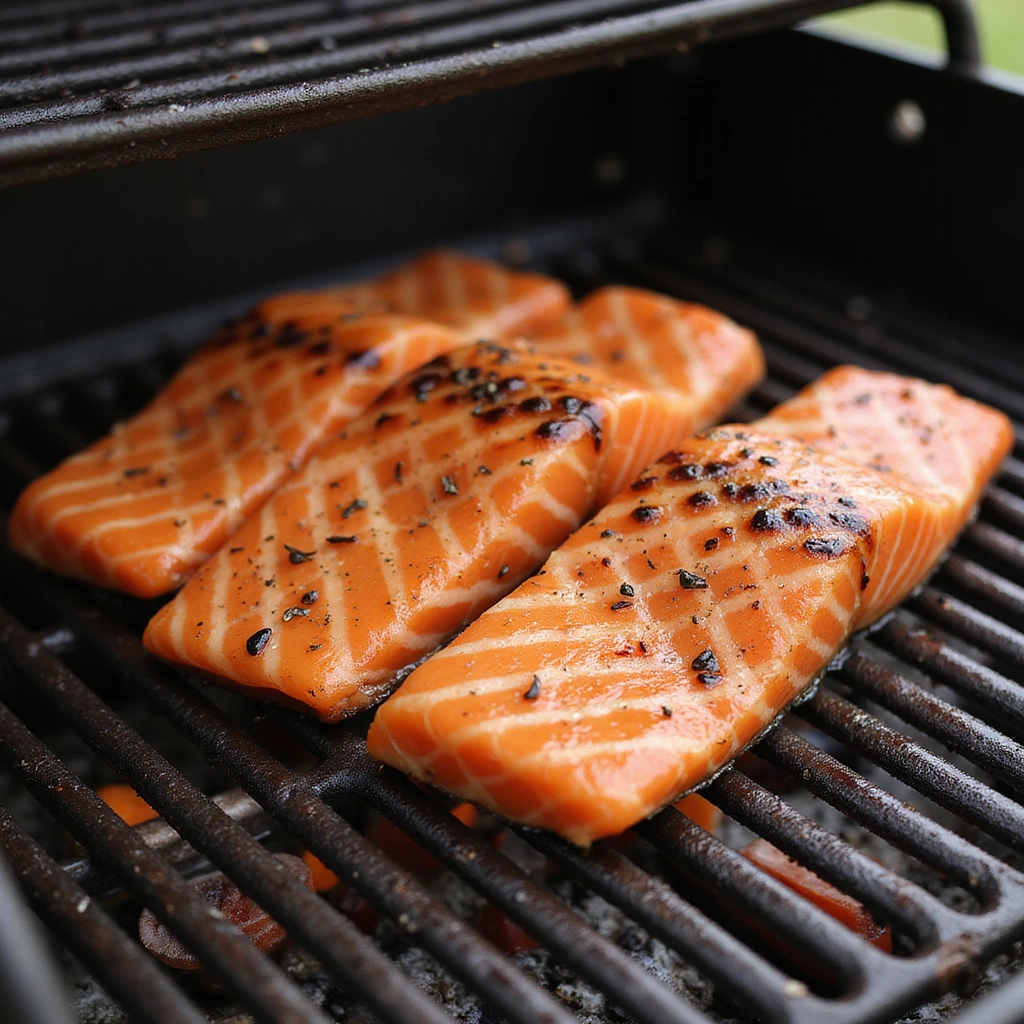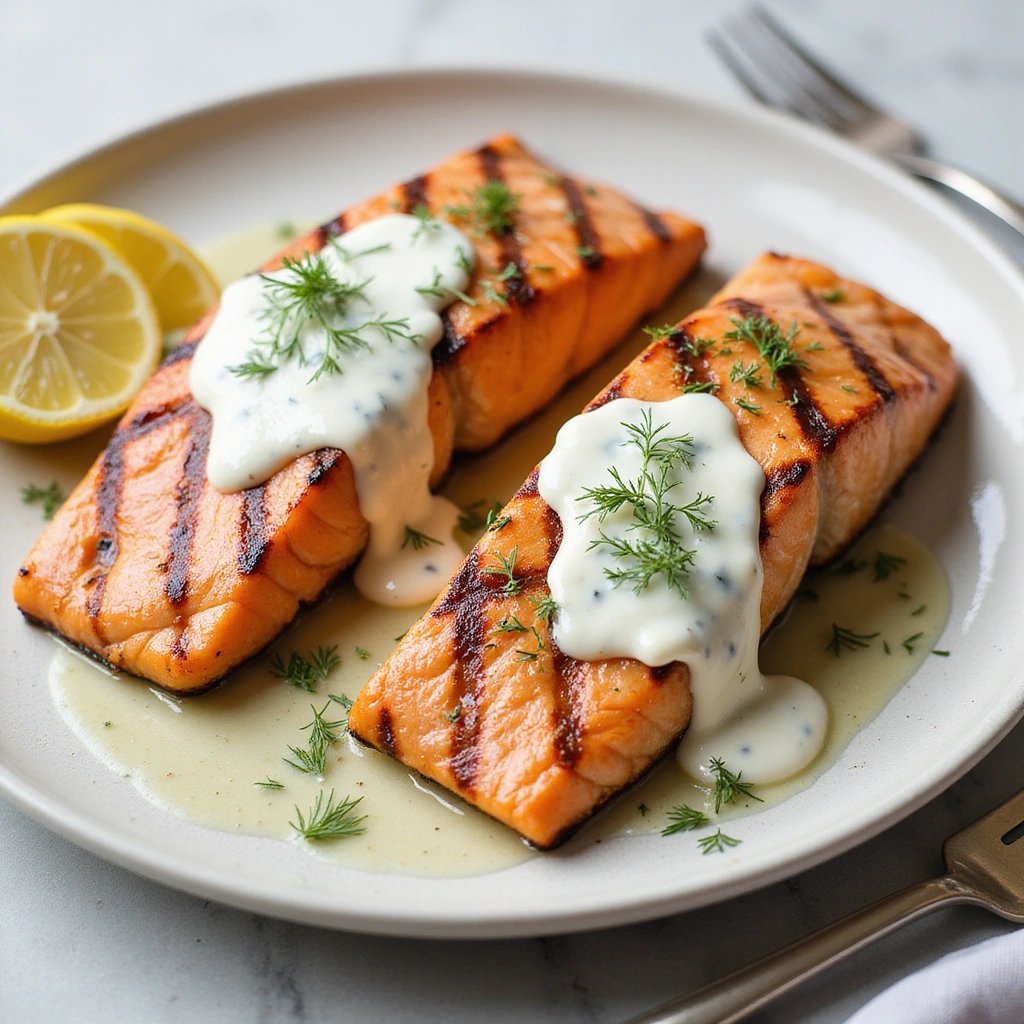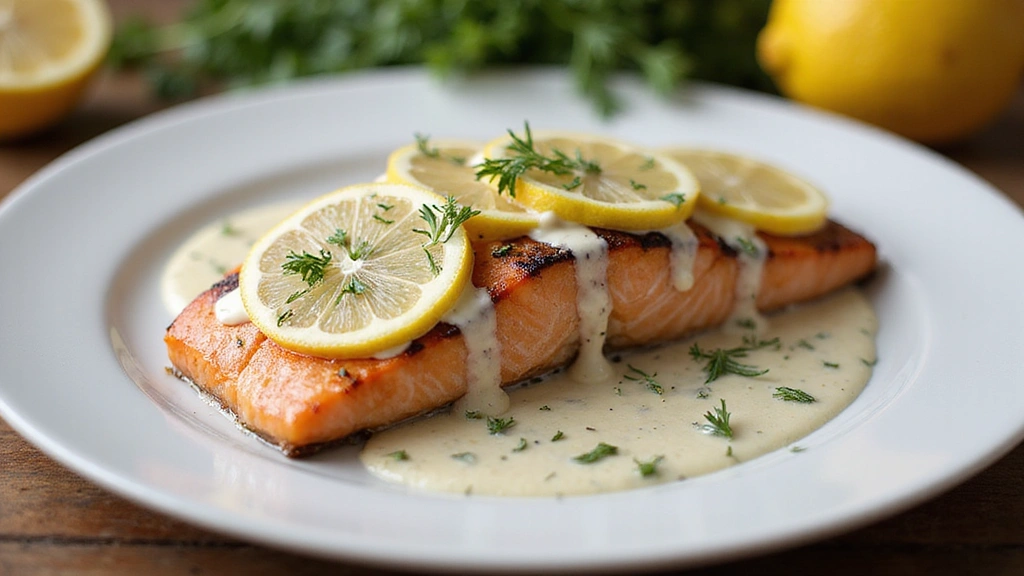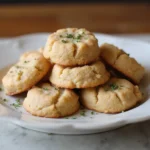Grilled Salmon with Lemon-Dill Sauce is a delightful dish that celebrates the fresh flavors of the sea.
The tender and flaky salmon is perfectly complemented by a zesty lemon-dill sauce that adds brightness and depth.
This dish is not only delicious but also incredibly easy to prepare, making it a favorite for both weeknight dinners and special occasions.
Whether served with a side of grilled vegetables or a fresh salad, this recipe is sure to impress family and friends.
The History and Cultural Significance
– Salmon has been a staple in the diets of various cultures, especially among indigenous peoples of the Pacific Northwest.
– Grilling fish is a common cooking method in many coastal regions, providing a delicious smoky flavor.
– Lemon and dill are traditional accompaniments to salmon, enhancing its natural flavors.
– Grilled Salmon with Lemon-Dill Sauce has evolved into a popular dish in contemporary cuisine, blending classic and modern cooking techniques.
Recipe Overview
Nutritional Information
Ingredients
Essential Equipment Guide
You will need a grill or grill pan for cooking the salmon.
A fish spatula will help you turn the salmon without breaking it apart.
A mixing bowl is necessary for preparing the lemon-dill sauce.
A whisk or spoon will be handy for mixing the sauce ingredients.
Preparation Methods
Marinating the salmon in olive oil enhances flavor and prevents sticking on the grill.
Grilling should be done over medium-high heat to achieve a perfect char.
Mixing the lemon-dill sauce requires careful incorporation of ingredients to create a smooth texture.
Step 1: Prepare the Lemon-Dill Sauce

In a mixing bowl, combine Greek yogurt, fresh dill, lemon juice, minced garlic, salt, and black pepper.
Whisk everything together until smooth and well blended.
Taste and adjust seasoning if necessary.
Step 2: Preheat the Grill

Preheat your grill to medium-high heat (about 375°F to 450°F).
Make sure the grill grates are clean and lightly oiled to prevent sticking.
Step 3: Prepare the Salmon

Pat the salmon fillets dry with paper towels.
Brush both sides with olive oil and season with salt and pepper.
Let the salmon sit at room temperature for 15 minutes before grilling.
Step 4: Grill the Salmon

Place the salmon fillets skin-side down on the grill.
Grill for about 5-6 minutes without moving them to get a good sear.
Carefully flip the salmon using a fish spatula and grill for another 4-5 minutes until cooked through.
Step 5: Check for Doneness

The salmon is done when it flakes easily with a fork and reaches an internal temperature of 145°F.
If necessary, cook for an additional minute or two.
Step 6: Serve the Salmon

Remove the salmon from the grill and let it rest for a couple of minutes.
Plate the salmon and drizzle with the prepared lemon-dill sauce.
Garnish with additional dill or lemon wedges if desired.
Step 7: Enjoy!

Serve the grilled salmon with your choice of sides such as grilled vegetables or a fresh salad.
Enjoy the fresh and zesty flavors of this delightful dish.
Pair with a glass of white wine for a complete meal.
Critical Timing and Temperature Guide
Grill salmon for 5-6 minutes on the first side and 4-5 minutes on the second side.
Ensure the internal temperature reaches 145°F for safe consumption.
Let the salmon rest for 2-3 minutes before serving.
Pro Tips for Grilled Salmon With Lemon-Dill Sauce
– Use fresh salmon for the best flavor and texture.
– Don’t flip the salmon too early; wait for a good sear.
– Experiment with different herbs in the sauce for variety.
– Consider marinating the salmon in lemon juice for an hour before grilling.
– If using a grill pan, heat it well to get a nice char.
– Serve with seasonal vegetables for a balanced meal.
– For extra zing, add a pinch of red pepper flakes to the sauce.
Troubleshooting Common Issues
– If the salmon sticks to the grill, make sure to oil the grates properly.
– If the salmon is overcooked, use a lower heat next time to prevent drying out.
– If the sauce is too tangy, add a teaspoon of honey to balance the flavors.
– If the salmon is undercooked, return it to the grill for additional minutes.
– If using frozen salmon, ensure it is completely thawed before grilling.
Variations and Regional Differences
In some regions, grilled salmon is served with a teriyaki glaze instead of lemon-dill sauce.
In Mediterranean cultures, olive oil, garlic, and herbs are commonly used as marinades.
Some variations incorporate different citrus fruits like orange or lime into the sauce.
Food Science Behind the Recipe
The Maillard reaction occurs when grilling, creating a flavorful crust on the salmon.
Marinating in olive oil helps to tenderize the fish and enhance its moisture retention.
The acidity in lemon juice not only adds flavor but also helps in breaking down proteins, making the salmon more tender.
Frequently Asked Questions
Can I use frozen salmon?
Yes, but ensure it is fully thawed before cooking.
How can I tell when the salmon is done?
It should flake easily with a fork and reach an internal temperature of 145°F.
What sides pair well with grilled salmon?
Grilled vegetables, salads, or rice dishes complement it well.
Can I make the sauce ahead of time?
Yes, you can prepare the lemon-dill sauce a day in advance and store it in the refrigerator.
What if I don’t have dill?
Fresh parsley or tarragon can be used as alternatives.
How do I store leftovers?
Store leftover salmon in an airtight container in the fridge for up to 3 days.
Can I grill salmon without skin?
Yes, but it may require careful handling to prevent it from falling apart.
Serving and Presentation Guide
Serve the grilled salmon on a warm plate to retain heat.
Drizzle the lemon-dill sauce generously over the top.
Garnish with fresh dill and lemon wedges for a pop of color.
Consider adding a side of vibrant roasted vegetables for visual appeal.
Conclusion
Grilled Salmon with Lemon-Dill Sauce is a fresh and zesty dish that is both simple and elegant.
With its delightful flavors, it’s perfect for any occasion.
Try this recipe and enjoy a taste of the sea right at home.


